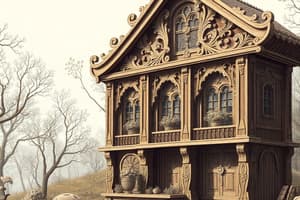Podcast
Questions and Answers
What is a disadvantage of wood related to its dimensions?
What is a disadvantage of wood related to its dimensions?
- Wood is never dimensionally true. (correct)
- Wood is always weight-efficient.
- Wood is impervious to weather changes.
- Wood dimensions are consistent across all species.
Which intrinsic defect in wood can compromise its structural integrity?
Which intrinsic defect in wood can compromise its structural integrity?
- High moisture content.
- Type of finish applied.
- Color variations.
- Knots or knotholes. (correct)
What factors can affect the strength of wood?
What factors can affect the strength of wood?
- Only the tree species.
- Environmental humidity alone.
- Temperature variations during storage.
- Growth rate and age of the tree. (correct)
What is a characteristic of dimensional lumber?
What is a characteristic of dimensional lumber?
What is a common misconception about the shrinkage and swelling of wood?
What is a common misconception about the shrinkage and swelling of wood?
Flashcards are hidden until you start studying
Study Notes
Disadvantages of Wood
- Wood is not dimensionally true, meaning its exact measurements are often unpredictable.
- Weather conditions, such as humidity and temperature, significantly impact the size and shape of wood.
- Swelling and shrinkage of wood are not uniform, leading to potential issues in construction and aesthetics.
- Common intrinsic defects in wood include:
- Knots, which can weaken the structure.
- Knotholes, impacting appearance and strength.
- Decay from fungal infections that compromise integrity.
- Insect damage from pests like termites and beetles.
- Splits caused by the drying process or stress.
- Warping, which distorts the shape of the wood.
- Wood strength varies widely based on species, grade, age, and the growth rate of the tree, affecting its suitability for specific applications.
- The strength of wood products may diminish over time after they have been placed in use.
Solid Lumber
- Solid lumber consists of dimensional lumber, boards, and timbers, each serving different purposes in construction.
- The standard measurements for dimensional lumber align with the stated dimensions, ensuring clarity in sizing.
- Dimensional lumber lengths typically range from 8 to 24 feet (2.5 to 7 m), with increments of 2 feet (600 mm).
- Finished boards and timbers differ from dimensional lumber as they are often described using nominal dimensions rather than the exact measurements, sometimes leading to confusion in specifications.
Studying That Suits You
Use AI to generate personalized quizzes and flashcards to suit your learning preferences.



